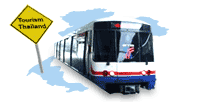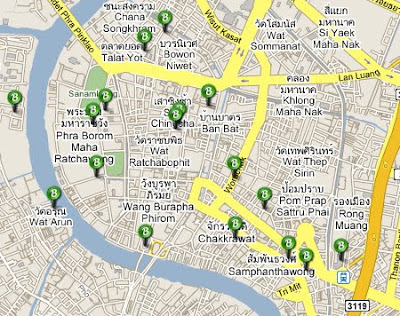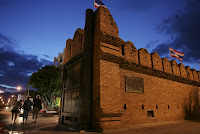 CENTRAL & EAST COAST
CENTRAL & EAST COAST There are 26 provinces that make up Central and Eastern Thailand, and Bangkok is one of them. Geographically, this is Thailand’s heartland, extending from Lop Buri in the north and covering the rice bowl of the Central Plains around the Chao Phraya River. Further south, the area embraces the east and west coasts of the upper Gulf of Thailand.
This is Thailand’s most fertile farming area, a wide-ranging landscape of paddy fields, orchards and plantations. More than 1,000 years ago Thai settlers moved down from the north, gradually replacing Mon and Khmer influences and establishing communities at Lop CENTRAL & EAST COAST Buri then at Sukhothai, before founding a kingdom that lasted 417 years with Ayutthaya as its capital. When the Burmese destroyed Ayutthaya in 1767, the capital moved to Bangkok.
The Central region has a dramatic history, and its heritage of ancient temples, battlefields and ruins and two capitals, Ayutthaya and Bangkok, are a continuing fascination for visitors. The east and west sea coasts at the region’s southern end also draw huge numbers of visitors every year. Bangkok residents spend long weekends enjoying the relaxing seaside atmosphere, while holiday-makers from around the world to discover the delights of the tropical beach life.

On the eastern side, 400 kilometres of coastline extend from Chon Buri to Rayong with some of the finest beaches in Asia. Pattaya, with an enormous range of resorts, hotels and guesthouses, is its centre. If you are seeking a more relaxing experience, travel further down the coast to Rayong or Ko Samet, and the lovely islands of Ko Chang National Park near the Cambodian border.
On the west coast, the resorts of Cha-am and Hua Hin attract international travellers who prefer their more sophisticated yet laid-back atmosphere.
Far from the sea in the northwest of the region is Kanchanaburi, whose forested mountains, waterfalls and caves, national parks and wildlife sanctuaries on the border with Myanmar provide some of Thailand’s most enthralling scenery.
The 26 provinces of Central and East Coast are Ang Thong, Bangkok, Chachoengsao, Chai Nat, Chanthaburi, Chon Buri, Kanchanaburi, Lop Buri, Nakhon Nayok, Nakhon Pathom, Nonthaburi, Pathum Thani, Phetchaburi, Phra Nakhon Si Ayutthaya, Prachin Buri, Prachuap Khiri Khan, Ratchaburi, Rayong, Sa Kaeo, Samut Prakan, Samut Sakhon, Samut Songkhram, Saraburi, Sing Buri, Suphan Buri and Trat.
 THE NORTH
THE NORTH The North is the birthplace of the earliest Thai civilisation and has many sites of archaeological and cultural interest. Northern people are famous for their courtesy and hospitality, and the region is also noted for its variety of cultural traditions. Many tourists from the surrounding provinces converge on Chiang Mai for the annual Songkran Festival, and to Sukhothai for Loi Krathong.
The North falls into two distinct areas, the plains of the lower north from Nakhon Sawan to Sukhothai, and the mountainous upper north leading to borders of Myanmar and Laos. The mountain ranges along the borders are breathtaking, with waterfalls and fast-flowing rivers ideal for rafting. They are also the home of many ethnic hill people.
The region has three seasons, hot from March to May, wet from June to November and cool from December to February. High up in the mountains, though, “cool” may often mean extremely cold.
The Thai nation had its origins in the North, in city states that were gradually incorporated into the Lanna kingdom centred on Chiang Mai. Sukhothai became the first capital of Thailand, but the influence of the Lanna states of Laos and Myanmar can be clearly seen in the architecture and cuisine of the North.

The nomadic hill people of the region pursued their own course, moving back and forth across frontiers. There are six main tribal groups, Karen, Hmong, Lahu, Mien, Akha and Lisu, each with its own unique customs and clothing. Today, they are settled in villages on the mountainsides, a great attraction for travellers.
Most overseas visitors make for Chiang Mai, the northern capital, as a base for visiting ethnic tribes, soft adventure activities and shopping. Further north still, Chiang Rai and Mae Hong Son are centres for rafting, trekking and tours of tribal villages. To the south, the Historical Park at Sukhothai is an essential destination for all those wishing to discover more about the history and culture of Thailand.
The 17 provinces that comprise the North are Chiang Mai, Chiang Rai, Tak, Kamphaeng Phet, Lampang, Lamphun, Mae Hong Son, Nakhon Sawan, Nan, Phayao, Phetchabun, Phichit, Uthai Thani, Phitsanulok, Phrae, Sukhothai, and Uttaradit.
THE NORTHEAST
The Northeast of Thailand, a vast plateau covering nearly one third of the country, is usually known as Isan. It extends northwards to the Mekong River which divides Thailand from Laos, and to the south and it ends at the Dong Rek mountain range along the border with Cambodia.
It is known to be an arid region with soil of poor quality, but for tourism, Isan is one of the country’s most intriguing destinations with many Stone Age and Bronze Age dwellings and artifacts, and several significant temples that are a legacy of the great Khmer empire.
The sandstone shrines are popular tourist attractions, particularly the superbly restored sites at the historical parks of Phimai in Nakhon Ratchasima and Phanom Rung in Buri Ram. The great temple complex at Khao Phra Viharn in Si Sa Ket on the border with Cambodian is now accessible to visitors after a long period of isolation.
The Bronze Age settlements at Ban Chiang in the province of Udon Thani provide fascinating evidence of the work of the local potters some 5,000 years ago. The red and white pottery with characteristic “fingerprint” designs are thought to be the first earthenware vessels known to man.
Two of Thailand’s best-loved national parks, Khao Yai, Phu Kradung and Phu Rua in Loei, are in Isan. Other major attractions include the villages in Khorat and Khon Kaen where the beautiful local silk is woven by hand.

Isan is a comparatively poor region whose main income is from agriculture, and many of the younger people in the villages migrate to the city. But Isan folk have a distinctive character and dialect and a vigorous culture, with their old traditions still reflected in the many festivals unique to the region.
With its strategic position bordering Laos and Cambodia, Isan has in recent years risen to become a useful starting point for adventurous journeys to destinations along the mighty Mekong River. There have been important developments in infrastructure to accommodate what is expected to be a boom in tourism.
Travel in the region has been improved by domestic airlines with regular flights to regional airports; and it is no longer impossible to find luxury accommodation, especially in large provinces of Khon Kaen, Udon Thani Nakhon, Ratchasima and Ubon Ratchathani.
The Northeast consists of 19 provinces: Amnat Charoen, Buri Ram, Chaiyaphum, Kalasin, Khon Kaen, Loei, Maha Sarakham, Mukdahan, Nakhon Phanom, Nakhon Ratchasima, Nong Bua Lamphu, Nong Khai, Roi Et, Sakon Nakhon, Si Sa Ket, Surin, Ubon Ratchathani, Udon Thani and Yasothon.
THE SOUTH
This region extends southward along a narrow peninsula lying between the Andaman Sea its west side and the South China Sea on the east. It is a rich land in terms of the abundance of its natural resources, the fertility of its soil, the diversity of its people and its commercial viability.
The South is made up of 14 provinces from Chumphon in the north down to the Malaysian border 1,200 kilometres from Bangkok. It has a long coastline on either side with sandy beaches and offshore islands on both, and a rugged central hinterland of mountains and forests.
The east coast on the Gulf of Thailand always seems to be more relaxed, with long, wide bays and calm seas; the Andaman Sea coast tends to be more rugged and exhilarating, with its strange limestone rock formations and cliffs.
The occurrence of two seasonal monsoons means that the climate differs from the rest of Thailand. The southwest monsoon sweeps the west coast and the Andaman Sea from May to October, while the northeast monsoon moves across the Gulf of Thailand form November to February. The peninsula forms a barrier so that rain rarely falls on both coastlines simultaneously.

The area was once part of the Buddhist Srivijaya Empire but later came under the rule of Ayutthaya and then Bangkok. Chinese and Malaysian influences have played a large part in the cultural makeup of the region; the further south, the stronger the Malaysian influence, with a dialect akin to Malay, a predominance of Muslim communities and mosques. Rice fields give way to rubber plantations, and Chinese tin mining operations become evidence.
The coastline attracts most tourists, though Samui island in the Gulf of Thailand is growing in popularity as a laid-back holiday spot with first class diving opportunities nearby on Tao and Pha-ngan islands.

The Andaman Sea coast offers more sophisticated choices in the island province of Phuket, Thailand’s premier holiday resort. However, the fascinating rock formations and offshore islands at Phang-nga, Krabi and Trang are extremely popular for the diving and sailing opportunities they offer.
The mountains, rivers and forests in the national parks in the interior of the peninsula are also gaining popularity with eco-tourists, as can be seen with the growing numbers of safari expeditions on foot, by elephant and in canoes.
The South of Thailand consists of 14 provinces: Chumphon, Krabi, Nakhon Si Thammarat, Narathiwat, Pattani, Phang-nga, Phatthalung, Phuket, Ranong, Satun, Songkhla, Surat Thani, Trang and Yala.
 BUS
BUS TAXI
TAXI TUK-TUKS
TUK-TUKS BTS Sky Trains
BTS Sky Trains Subway (Metro)
Subway (Metro) Boat
Boat









































